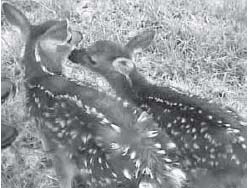By Anne Muller
The Wildlife Watch hotline number brings in numerous calls
during spring and early summer. It’s the time of
year that wildlife rehabbers (rehabilitators) call "baby
season.” I have to admit that responding to these
calls is by far the most immediately rewarding aspect of
our work. Often on the phone with a panicked caller, we
can determine that the animal doesn’t need help because
mom is still around. Other times, we are able to unite
people who have an injured animal with those who can help
them.
Here is why wildlife rehabilitators are so special: It’s a rare veterinarian who treats wildlife. Rehabilitators receive no state money. They undertake rehabilitation at their own expense, time, and effort for the personal satisfaction of helping wild animals and for an occasional contribution.
Our hats go off to those noble souls who care for other creatures as though they were members of their own family and, from a higher vantage ground, they indeed are.

Photo by Anne Muller
A beaming Mary Bell watches over the fawns
|
When Mary and Gary Bell exchanged wedding vows, it must have gone something like this: You get ‘em and I’ll take care of ‘em. Fawns, that is. And that’s what the Bells have been doing ever since. In spite of full-time jobs, Gary brings orphaned fawns to Mary who feeds them on schedule, putting all other engagements and demands behind her commitment to the fawns. Speaking lovingly to the fawns as though they’re children, cleaning their little rears with leaves, and providing them with nourishment, the Bells ensure that their charges will be reintroduced to the “wild” when the babies reach maturity.
Sometimes, the totally cured and
mature “patient” doesn’t want to leave.
The Bells still have a groundhog, Porkchop, who insists
on visiting often, literally knocking on the kitchen door
and waiting for his big green leaf of kale (See photo in “Hotel
Bell Photo Gallery” below.). A rescued squirrel hangs
out in the yard and watches the antics of the people and
former nurses, leaving only when he gets bored.
The deer, according to Mary, stay nearby for a few days, but then she rarely sees them again. Mary confessed that she often thinks of them and would love to know how they fare.
Mary and Gary, licensed rehabilitators, will accept any animal, but are partial to fawns, squirrels, and woodchucks. They’ve established a network with other rehabbers, some who specialize in birds, others in reptiles, and fortunately, they have discovered a veterinarian who never refuses to treat a wild animal or provide them with information. He’s Dr. Dasaro of the Newburgh Animal Hospital. Mary credits her successful releases to both the rehabilitator network and the veterinarian.
Gary has traveled close to two hours to pick up an animal –
and he’ll get up in the middle of the night for a three-hour round trip if he gets a call. Mary has stayed up all night with an injured animal and then has gone to work the next day. Mary is casual about saying something extraordinary: they answer calls 24/7. She has reason to be proud of that fact. It’s rare. Because education also is vital to Mary’s philosophy, at least once a year, she visits a school or a community group to talk about what they do. They educate the public about what they should and shouldn’t do to help an animal. She said that the more she educates, the easier her job becomes.
You’re probably thinking that
Mary and Gary never had children. Wrong. They
have three happy, healthy children. They are all interested
in the
animals and share the same enthusiasm and love for wildlife
as their parents. Was Mary ever afraid that the animals
would make her children ill? As a professional hygienist,
Mary never had that concern. Mary and Gary express so much
gratitude to the wild animals who have made their family,
friends, and community so much “richer.”
The Hotel Bell Photo Gallery






